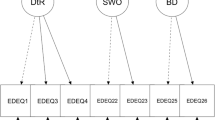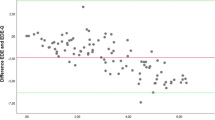Abstract
Previous research has demonstrated disparities in the diagnosis and treatment of eating disorders for men and ethnic minorities. The current study sought to investigate differences in eating pathology and measurement validity of the Eating Disorder Examination Questionnaire (EDE-Q) at the intersection of gender and ethnicity in a nonclinical sample of undergraduates. A total sample of 1173 undergraduates (177 Latino men, 133 non-Latino White men, 554 Latina women, 309 non-Latina White women) completed the EDE-Q as part of a larger study on eating habits. A series of ANOVAs indicated a similar pattern of effects for gender and ethnicity for the original four-factor, 22-item EDE-Q and an alternative three-factor, seven-item variant. Women scored significantly higher than men on all subscales, and Latinx participants scored significantly higher than non-Latinx White participants on the Shape Concern and Weight Concern subscales. A significant interaction of gender by ethnicity was observed on the Shape Concern subscale in which larger effects of ethnicity were observed for men compared to women. Tests of confirmatory factor analysis suggested only the three-factor, seven-item EDE-Q provided acceptable fit and demonstrated scalar invariance across gender and ethnicity. Our study highlights the importance of examining eating pathology and measurement validity at the intersection of demographic characteristics. Results suggest that Latino men may be at higher risk of eating pathology relative to non-Latino White men and that a three-factor, seven-item EDE-Q appears to be a valid measure of eating pathology across gender and ethnicity among U.S. undergraduates.
Similar content being viewed by others
References
Akan, G. E., & Grilo, C. M. (1995). Sociocultural influences on eating attitudes and behaviors, body image, and psychological functioning: A comparison of African-American, Asian-American, and Caucasian college women. International Journal of Eating Disorders, 18, 181–187. https://doi.org/10.1002/1098-108X(199509)18:2<181::AID-EAT2260180211>3.0.CO;2-M.
Becker, A. E., Franko, D. L., Speck, A., & Herzog, D. B. (2003). Ethnicity and differential access to care for eating disorder symptoms. International Journal of Eating Disorders, 33, 205–212. https://doi.org/10.1002/eat.10129.
Bozsik, F., Whisenhunt, B. L., Hudson, D. L., Bennett, B., & Lundgren, J. D. (2018). Thin is in? Think again: The rising importance of muscularity in the thin ideal female body. Sex Roles, 79, 609–615. https://doi.org/10.1007/s11199-017-0886-0.
Fairburn, C. G., & Beglin, S. J. (1994). Assessment of eating disorders: Interview or self-report questionnaire? International Journal of Eating Disorders, 16, 363–370. https://doi.org/10.1002/1098-108X(199412)16:4,363::AID-EAT2260160405/3.0.CO;2-%23.
Fairburn, C. G., & Beglin, S. J. (2008). Eating Disorder Examination Questionnaire (EDE-Q 6.0). In C. G. Fairburn (Ed.), Cognitive behavior therapy and eating disorders (pp. 309–314). New York: Guilford Press.
Franko, D. L., Becker, A. E., Thomas, J. J., & Herzog, D. B. (2007). Cross-ethnic differences in eating disorder symptoms and related distress. International Journal of Eating Disorders, 40, 156–164. https://doi.org/10.1002/eat.20341.
Franko, D. L., Jenkins, A., Roehrig, J. P., Luce, K. H., Crowther, J. H., & Rodgers, R. F. (2012). Psychometric properties of measures of eating disorder risk in Latina college women. International Journal of Eating Disorders, 45, 592–596. https://doi.org/10.1002/eat.20979.
Gentile, K., Raghavan, C., Rajah, V., & Gates, K. (2007). It doesn't happen here: Eating disorders in an ethnically diverse sample of economically disadvantaged, urban college students. Eating Disorders, 15, 405–425. https://doi.org/10.1080/10640260701667904.
George, V. A., Erb, A. F., Harris, C. L., & Casazza, K. (2007). Psychosocial risk factors for eating disorders in Hispanic females of diverse ethnic background and non-Hispanic females. Eating Behaviors, 8, 1–9. https://doi.org/10.1016/j.eatbeh.2005.08.004.
Grabe, S., & Hyde, J. S. (2006). Ethnicity and body dissatisfaction among women in the United States: A meta-analysis. Psychological Bulletin, 132, 622–640. https://doi.org/10.1037/0033-2909/132.4.622.
Grilo, C. M., Reas, D. L., Hopwood, C. J., & Crosby, R. D. (2015). Factor structure and construct validity of the Eating Disorder Examination-Questionnaire in college students: Further support for a modified brief version. International Journal of Eating Disorders, 48, 284–289. https://doi.org/10.1002/eat.22358.
Hu, L. T., & Bentler, P. M. (1999). Cutoff criteria for fit indexes in covariance structure analysis: Conventional criteria versus new alternatives. Structural Equation Modeling: A Multidisciplinary Journal, 6, 1–55. https://doi.org/10.1080/10705519909540118.
Hudson, J. I., Hiripi, E., Pope Jr., H. G., & Kessler, R. C. (2007). The prevalence and correlates of eating disorders in the National Comorbidity Survey Replication. Biological Psychiatry, 61, 348–358. https://doi.org/10.1016/j.biopsych.2006.03.040.
IBM Corp. (2017). IBM SPSS statistics for windows, version 25.0. Armonk: IBM Corp.
Jennings, K. M., & Phillips, K. E. (2017). Eating Disorder Examination–Questionnaire (EDE–Q): Norms for a clinical sample of males. Archives of Psychiatric Nursing, 31, 73–76. https://doi.org/10.1016/j.apnu.2016.08.004.
Kelly, N. R., Cotter, E. W., & Mazzeo, S. E. (2012). Eating Disorder Examination Questionnaire (EDE-Q): Norms for Black women. Eating Behaviors, 13, 429–432. https://doi.org/10.1016/j.eatbeh.2012.09.001.
Kliem, S., Mößle, T., Zenger, M., Strauß, B., Brähler, E., & Hilbert, A. (2016). The Eating Disorder Examination-Questionnaire 8: A brief measure of eating disorder psychopathology (EDE-Q8). International Journal of Eating Disorders, 49, 613–616. https://doi.org/10.1002/eat.22487.
Kline, R. B. (2011). Principles and practice of structural equation modeling. New York, New York: The Guilford Press.
Lavender, J. M., De Young, K. P., & Anderson, D. A. (2010). Eating Disorder Examination Questionnaire (EDE-Q): Norms for undergraduate men. Eating Behaviors, 11, 119–121. https://doi.org/10.1016/j.eatbeh.2009.09.005.
Lipson, S. K., & Sonneville, K. R. (2017). Eating disorder symptoms among undergraduate and graduate students at 12 US colleges and universities. Eating Behaviors, 24, 81–88. https://doi.org/10.1016/j.eatbeh.2016.003.
Marques, L., Alegria, M., Becker, A. E., Chen, C. N., Fang, A., Chosak, A., … Diniz, J. B. (2011). Comparative prevalence, correlates of impairment, and service utilization for eating disorders across US ethnic groups: Implications for reducing ethnic disparities in health care access for eating disorders. International Journal of Eating Disorders, 44, 412–420. https://doi.org/10.1002/eat.20787.
Menon, C. V., & Harter, S. L. (2012). Examining the impact of acculturative stress on body image disturbance among Hispanic college students. Cultural Diversity and Ethnic Minority Psychology, 18, 239–246. https://doi.org/10.1037/a0028638.
Mond, J., Hall, A., Bentley, C., Harrison, C., Gratwick-Sarll, K., & Lewis, V. (2014). Eating-disordered behavior in adolescent boys: Eating Disorder Examination Questionnaire norms. International Journal of Eating Disorders, 47, 335–341. https://doi.org/10.1002/eat.22237.
Mond, J. M., Hay, P. J., Rodgers, B., Owen, C., & Beumont, P. J. V. (2004). Validity of the Eating Disorder Examination Questionnaire (EDE-Q) in screening for eating disorders in community samples. Behaviour Research and Therapy, 42, 551–567. https://doi.org/10.1016/S0005-7967(03)00161-X.
Murray, S. B., Nagata, J. M., Griffiths, S., Calzo, J. P., Brown, T. A., Mitchison, D., … Mond, J. M. (2017). The enigma of male eating disorders: A critical review and synthesis. Clinical Psychology Review, 57, 1–11. https://doi.org/10.1016/j.cpr.2017.08.001.
Muthén, L. K., & Muthén, B. O. (1998-2017). Mplus user’s guide (8th). Los Angeles: Muthén & Muthén
Nakai, Y., Nin, K., Fukushima, M., Nakamura, K., Noma, S., Teramukai, S., … Wonderlich, S. (2014). Eating Disorder Examination Questionnaire (EDE-Q): Norms for undergraduate Japanese women. European Eating Disorders Review, 22, 439–442. https://doi.org/10.1002/erv.2324.
Penelo, E., Negrete, A., Portell, M., & Raich, R. M. (2013). Psychometric properties of the Eating Disorder Examination Questionnaire (EDE-Q) and norms for rural and urban adolescent males and females in Mexico. PLoS One, 8, e83245. https://doi.org/10.1371/journal.pone.0083245.
Perez, M., Ohrt, T. K., & Hoek, H. W. (2016). Prevalence and treatment of eating disorders among Hispanics/Latino Americans in the United States. Current Opinion in Psychiatry, 29, 378–382. https://doi.org/10.1097/YCO.0000000000000277.
Perez, M., & Warren, C. S. (2013). Assessing eating pathology in Hispanic Americans. In L. T. Benuto (Ed.), Guide to psychological assessment with Hispanics (pp. 201–214). New York: Springer.
Pernick, Y., Nichols, J. F., Rauh, M. J., Kern, M., Ji, M., Lawson, M. J., … Wilfley, D. (2006). Disordered eating among a multi-racial/ethnic sample of female high-school athletes. Journal of Adolescent Health, 38, 689–695. https://doi.org/10.1016/j.jadohealth.2005.07.003.
Rand-Giovannetti, D., Cicero, D. C., Mond, J. M., & Latner, J. D. (2017). Psychometric properties of the Eating Disorder Examination–Questionnaire (EDE-Q): A confirmatory factor analysis and assessment of measurement invariance by sex. Assessment, 27, 164–167. https://doi.org/10.1177/1073191117738046.
Reas, D. L., Øverås, M., & Rø, Ø. (2012). Norms for the Eating Disorder Examination Questionnaire (EDE-Q) among high school and university men. Eating Disorders, 20, 437–443. https://doi.org/10.1177/1073191117738046.
Ricciardelli, L. A., McCabe, M. P., Williams, R. J., & Thompson, J. K. (2007). The role of ethnicity and culture in body image and disordered eating among males. Clinical Psychology Review, 27, 582–606. https://doi.org/10.1016/j.cpr.2007.01.016.
Rodgers, R. F., Berry, R., & Franko, D. L. (2018). Eating disorders in ethnic minorities: An update. Current Psychiatry Reports, 20, 90–100. https://doi.org/10.1007/s.11920-018-0938-3.
Schaefer, L. M., Smith, K. E., Leonard, R., Wetterneck, C., Smith, B., Farrell, N., … Thompson, J. K. (2018). Identifying a male clinical cutoff on the Eating Disorder Examination-Questionnaire (EDE-Q). International Journal of Eating Disorders, 51, 1357–1360. https://doi.org/10.1002/eat.22972.
Serier, K. N., Smith, J. E., & Yeater, E. A. (2018). Confirmatory factor analysis and measurement invariance of the Eating Disorder Examination Questionnaire (EDE-Q) in a nonclinical sample of non-Hispanic white and Hispanic women. Eating Behaviors, 31, 53–59. https://doi.org/10.1016/j.eatbeh.2018.08.004.
Shaw, H., Ramirez, L., Trost, A., Randall, P., & Stice, E. (2004). Body image and eating disturbances across ethnic groups: More similarities than differences. Psychology of Addictive Behaviors, 18, 12–18. https://doi.org/10.1037/0893-164X.19.1.12.
Smith, J. M., Smith, J. E., McLaughlin, E. A., Belon, K. E., Serier, K. N., Simmons, J. D., … Delaney, H. D. (2020). Body dissatisfaction and disordered eating in Native American, Hispanic, and White college women. Eating and Weight Disorders - Studies on Anorexia, Bulimia and Obesity, 25, 347–355. https://doi.org/10.1007/s40519-018-0597-8.
Smith, K. E., Mason, T. B., Murray, S. B., Griffiths, S., Leonard, R. C., Wetterneck, C. T., … Lavender, J. M. (2017). Male clinical norms and sex differences on the eating disorder inventory (EDI) and eating disorder examination questionnaire (EDE-Q). International Journal of Eating Disorders, 50, 769–775. https://doi.org/10.1002/eat.22716.
Stein, K. F., Chen, D. G. D., Corte, C., Keller, C., & Trabold, N. (2013). Disordered eating behaviors in young adult Mexican American women: Prevalence and associations with health risks. Eating Behaviors, 14, 476–483. https://doi.org/10.1016/j.eatbeh.2013.08.001.
Strother, E., Lemberg, R., Stanford, S. C., & Turberville, D. (2012). Eating disorders in men: Underdiagnosed, undertreated, and misunderstood. Eating Disorders, 20, 346–355.
Thompson, J. K., Heinberg, L. J., Altabe, M., & Tantleff-Dunn, S. (1999). Exacting beauty: Theory, assessment, and treatment of body image disturbance. Washington DC: American Psychological Association.
Thompson, J. K., & Stice, E. (2001). Thin-ideal internalization: Mounting evidence for a new risk factor for body-image disturbance and eating pathology. Current Directions in Psychological Science, 10, 181–183. https://doi.org/10.1111/1467-8721.00144.
Udo, T., & Grilo, C. M. (2018). Prevalence and correlates of DSM-5–defined eating disorders in a nationally representative sample of US adults. Biological Psychiatry, 84, 345–354. https://doi.org/10.1016/j.biopsycho.2018.03.014.
Villarroel, A. M., Penelo, E., Portell, M., & Raich, R. M. (2011). Screening for eating disorders in undergraduate women: Norms and validity of the Spanish version of the Eating Disorder Examination Questionnaire (EDE-Q). Journal of Psychopathology and Behavioral Assessment, 33, 121–128. https://doi.org/10.1007/s10862-009-9177-6.
Warren, C. S., & Rios, R. M. (2013). The relationships among acculturation, acculturative stress, endorsement of Western media, social comparison, and body image in Hispanic male college students. Psychology of Men & Masculinity, 14, 192–201. https://doi.org/10.1037/a0028505.
Author information
Authors and Affiliations
Corresponding author
Additional information
Publisher’s Note
Springer Nature remains neutral with regard to jurisdictional claims in published maps and institutional affiliations.
Electronic supplementary material
ESM 1
(DOCX 16.2 kb)
Rights and permissions
About this article
Cite this article
McEntee, M.L., Serier, K.N., Smith, J.M. et al. The Sum Is Greater than its Parts: Intersectionality and Measurement Validity of the Eating Disorder Examination Questionnaire (EDE-Q) in Latinx Undergraduates in the United States. Sex Roles 84, 102–111 (2021). https://doi.org/10.1007/s11199-020-01149-7
Published:
Issue Date:
DOI: https://doi.org/10.1007/s11199-020-01149-7




